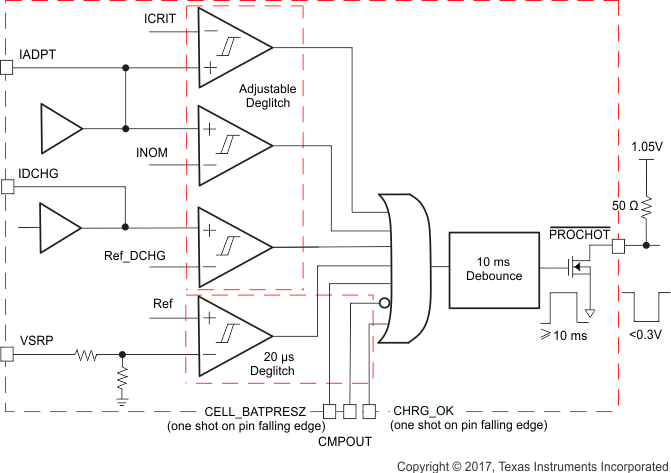SLUSCU1A May 2017 – May 2018
PRODUCTION DATA.
- 1 Features
- 2 Applications
- 3 Description
- 4 Revision History
- 5 Description (continued)
- 6 Pin Configuration and Functions
- 7 Specifications
-
8 Detailed Description
- 8.1 Overview
- 8.2 Functional Block Diagram
- 8.3
Feature Description
- 8.3.1 Power-Up from Battery Without DC Source
- 8.3.2 Power-Up From DC Source
- 8.3.3 USB On-The-Go (OTG)
- 8.3.4 Converter Operation
- 8.3.5 Current and Power Monitor
- 8.3.6 Input Source Dynamic Power Manage
- 8.3.7 Two-Level Adapter Current Limit (Peak Power Mode)
- 8.3.8 Processor Hot Indication
- 8.3.9 Device Protection
- 8.4 Device Functional Modes
- 8.5 Programming
- 8.6
Register Map
- 8.6.1
Setting Charge and PROCHOT Options
- 8.6.1.1 ChargeOption0 Register (I2C address = 01/00h) [reset = E20Eh]
- 8.6.1.2 ChargeOption1 Register (I2C address = 31/30h) [reset = 211h]
- 8.6.1.3 ChargeOption2 Register (I2C address = 33/32h) [reset = 2B7]
- 8.6.1.4 ChargeOption3 Register (I2C address = 35/34h) [reset = 0h]
- 8.6.1.5 ProchotOption0 Register (I2C address = 37/36h) [reset = 04A54h]
- 8.6.1.6 ProchotOption1 Register (I2C address = 39/38h) [reset = 8120h]
- 8.6.1.7 ADCOption Register (I2C address = 3B/3Ah) [reset = 2000h]
- 8.6.2 Charge and PROCHOT Status
- 8.6.3 ChargeCurrent Register (I2C address = 03/02h) [reset = 0h]
- 8.6.4 MaxChargeVoltage Register (I2C address = 05/04h) [reset value based on CELL_BATPRESZ pin setting]
- 8.6.5 MinSystemVoltage Register (I2C address = 0D/0Ch) [reset value based on CELL_BATPRESZ pin setting]
- 8.6.6 Input Current and Input Voltage Registers for Dynamic Power Management
- 8.6.7 OTGVoltage Register (I2C address = 07/06h) [reset = 0h]
- 8.6.8 OTGCurrent Register (I2C address = 09/08h) [reset = 0h]
- 8.6.9 ADCVBUS/PSYS Register (I2C address = 27/26h)
- 8.6.10 ADCIBAT Register (I2C address = 29/28h)
- 8.6.11 ADCIINCMPIN Register (I2C address = 2B/2Ah)
- 8.6.12 ADCVSYSVBAT Register (I2C address = 2D/2Ch)
- 8.6.13 ID Registers
- 8.6.1
Setting Charge and PROCHOT Options
- 9 Application and Implementation
- 10Power Supply Recommendations
- 11Layout
- 12Device and Documentation Support
- 13Mechanical, Packaging, and Orderable Information
Package Options
Mechanical Data (Package|Pins)
- RSN|32
Thermal pad, mechanical data (Package|Pins)
- RSN|32
Orderable Information
8.3.8 Processor Hot Indication
When CPU is running turbo mode, the system peak power may exceed available power from adapter and battery together. The adapter current and battery discharge peak current, or system voltage drop is indication that system power is too high. The charger processor hot function monitors these events, and PROCHOT pulse is asserted. Once CPU receives PROCHOT pulse from charger, it slows down to reduce system power. The processor hot function monitors these events, and PROCHOT pulse is asserted.
The PROCHOT triggering events include:
- ICRIT: adapter peak current, as 110% of ILIM2
- INOM: adapter average current (110% of input current limit)
- IDCHG: battery discharge current
- VSYS: system voltage on VSYS
- Adapter Removal: upon adapter removal (CHRG_OK pin HIGH to LOW)
- Battery Removal: upon battery removal (CELL_BATPRESZ pin goes LOW)
- CMPOUT: Independent comparator output (CMPOUT pin HIGH to LOW)
The threshold of ICRIT, IDCHG or VSYS, and the deglitch time of ICRIT, INOM, IDCHG or CMPOUT are programmable through I2C. Each triggering event can be individually enabled in REG0x38[6:0]. When any event in PROCHOT profile is triggered, PROCHOT is asserted low for minimum 10 ms programmable in 0x36[4:3]. At the end of the 10 ms, if the PROCHOT event is still active, the pulse gets extended.
